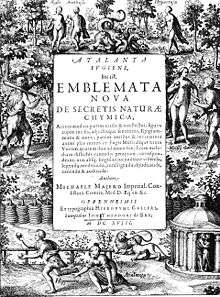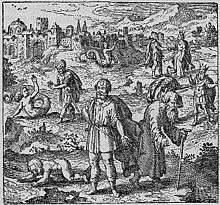Atalanta Fugiens
Atalanta Fugiens or Atalanta Fleeing is an emblem book by Michael Maier (1568–1622), published by Johann Theodor de Bry in Oppenheim in 1617 (2nd edition 1618). It consists of 50 discourses with illustrations by Matthias Merian, each of which is accompanied by an epigrammatic verse, prose and a musical fugue. It may therefore be considered an early example of multimedia.
 Title page. | |
| Author | Michael Maier |
|---|---|
| Original title | Atalanta Fugiens, hoc est, Emblemata Nova de Secretis Naturae Chymica, Accommodata partim oculis et intellectui, figuris cupro incisis, adjectisquesententiis, Epigrammatis et notis, partim auribus & recreationi animi plus minus 50 Fugis Musicalibus trium Vocum, quarum duae ad unam simplicem melodiam distichis canendis peraptam, correspondeant, non absq; singulari jucunditate videnda, legenda, meditanda, intelligenda, dijudicanda, canenda et audienda. |
| Illustrator | Matthias Merian |
| Subject | Alchemy |
| Genre | Multimedia |
| Published | Oppenheim |
| Publisher | Johann Theodor de Bry, printed by Hieronymus Galler |
Publication date | 1617 |
Title page
The title page depicts various scenes from Greek mythology related to golden apples:
- Top: Garden of the Hesperides.
- Left: Hercules stretching out his arm to seize one of the golden apples.
- Right: Aphrodite handing the golden apples to Hippomenes.
- Bottom: Race between Atalanta and Hippomenes, with Atalanta picking up an apple. Behind them is a temple with lovers embracing each other, while in the background they appear as a lion and lioness.
Preface

Maier's reinterpretation of the Riddle of the Sphinx as pictured in Emblem 39[1]
The preface contains a dissertation upon ancient music and narrates the Greek myth of Atalanta and Hippomenes.
Discourses
Each of the 50 discourses contains:
- A detailed copper-plated engraving by Matthias Merian.
- An epigram in verse set to music in the form of a fugue for three voices - Atalanta, or the vox fugiens; Hippomenes, or the vox sequens, and Pomum objectum (Apple) or vox morans. "Atalanta fugiens" is a play on the word "fugue"[2]
- An epigram in German.
- A Latin verse with an accompanying discourse.[3]
gollark: Every random service I add creates some extra maintenence work for me.
gollark: osmarks wiki™ will be produced *IF* someone ACTUALLY COMES UP WITH GOOD IDEAS FOR THE CONTENT WHICH CAN'T GO ANYWHERE ELSE.
gollark: a: We don't really *do* documentation at osmarks.tk.b: no.
gollark: What would be *on* osmarks.tk wiki™, and what wiki software would I use?
gollark: Technically, cloudflare uses hCaptcha or something.
References
- Peter Forshaw/Ritman Library - Ritman Library Webinar on 'Atalanta Fugiens., at 48:45
- Peter Forshaw/Ritman Library, at 18:15.
- Count Michael Maier: Life and writings J.B.Craven pub. 1914 reprinted 2003 Ibis Press
External links
- Copies at various websites:
- scribd.com (with engravings; without fugues, German epigrams)
- pagesperso-orange.fr (complete scanned text including German epigrams; with appendix, errata; without engravings, fugues)
- digital.sciencehistory.org (complete high-resolution scan of a 1618 printing, all pages including engravings and fugues)
- Images and other media at Wikimedia Commons
- English translation of Epigram Verse at wikisource
- alchemywebsite.com English translation of complete book
- youtube colored prints with instrumental version of the music for each emblem
- Forshaw, Peter J (2010) 'Oratorium-Auditorium-Laboratorium: Early Modern Improvisations on Cabala, Music and Alchemy'.
This article is issued from Wikipedia. The text is licensed under Creative Commons - Attribution - Sharealike. Additional terms may apply for the media files.